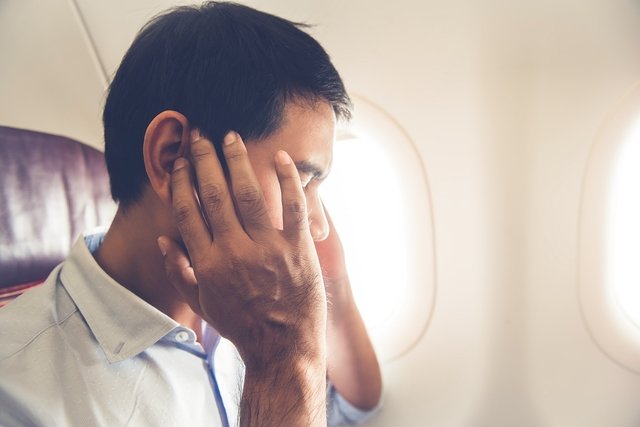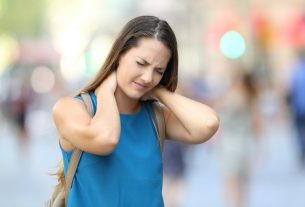The feeling of pressure in the ear can arise when there is a difference between the pressure inside the ear and atmospheric pressure, as happens during a plane trip, diving or climbing a mountain, for example, resulting in symptoms such as a feeling of a blocked or full ear. or difficulty listening.
In addition, the feeling of pressure in the ear can also occur due to water entering the ear, excess earwax, ear infections, flu, colds or sinusitis, for example, and be accompanied by other symptoms, such as ear pain or discharge. of pus.
Although it can be quite uncomfortable, most of the time, the feeling of pressure is not dangerous and ends within a few minutes. However, if the discomfort does not improve, if it worsens or if it is accompanied by other symptoms, you should consult an otorhinolaryngologist to identify the cause and begin the most appropriate treatment.

Main symptoms
The sensation of pressure in the ear may be accompanied by some symptoms, such as:
- Feeling of plugged or blocked ears;
- Muffled hearing or difficulty hearing;
- Feeling of full ears;
- Pain or discomfort in the ear;
- Buzzing or popping in the affected ear.
Furthermore, depending on the cause of the pressure in the ear, other symptoms may appear, such as fluid or pus coming out of the ear, fever, bleeding from the ear, dizziness, nausea, decreased or loss of hearing.
How to confirm the diagnosis
The diagnosis of ear pressure is made by an otorhinolaryngologist, through the evaluation of symptoms, health history and recent travel or diving history, for example.
Taking care of your health has never been easier!
In addition, your doctor should do a physical examination of the affected ear, using a device called an otoscope, to help visualize the inside of the ear and evaluate changes or infections in the ear.
Main causes of pressure in the ear
The main causes of pressure in the ear are:
- Changes in altitude, such as plane travel, diving, climbing mountains or taking elevators;
- Water entering the ear, while bathing or when using swimming pools, the sea or bathtubs;
- Flu, colds and sinusitis;
- Excess wax;
- Otitis media;
- Otitis externa or swimmer’s ear;
- Fungal infection in the ear;
- Allergic rhinitis;
- Entry of foreign objects into the ear or insects.
Furthermore, the sensation of pressure in the ear can be caused by labyrinthitis, Meniére’s disease, acoustic neuroma, cholesteatoma or temporomandibular dysfunction, for example.
What to do to relieve pressure in your ear
If pressure in the ear has arisen due to changes in altitude, you can yawn a few times, drink water or chew gum, as this can help rebalance the pressure inside the ear, relieving the feeling of a blocked ear. See other ways to unclog your ears.
However, if the pressure in the ear does not improve or is accompanied by other symptoms, you should consult an otolaryngologist so that the most appropriate treatment can be indicated.
How the treatment is carried out
The treatment of pressure in the ear must be carried out under the guidance of an otorhinolaryngologist and varies according to its cause.
Therefore, some treatments that may be recommended by the doctor are:
- Analgesic or anti-inflammatory medicationssuch as paracetamol or ibuprofen, to relieve ear pain and discomfort;
- Antibioticsin the form of tablets or ear drops, to treat bacterial infections;
- Antifungalsin cases of ear fungus infection;
- Antihistaminesfor the treatment of allergies;
- Nasal decongestantsin cases of colds, flu or nasal congestion.
If the pressure in the ear was caused by excess wax, the doctor should wash the ear, and if foreign objects or insects entered, the doctor should remove them.
In more serious cases, in which there is a prolonged accumulation of secretion in the ear, the doctor may recommend surgery to relieve pressure and unblock the ear.
Bibliography
- LINDFOURS, OH; et al. Middle ear barotrauma in diving. Diving Hyperb Med. 51. 1; 44-52, 2021
- LINDFOURS, OH; et al. Middle Ear Barotraumas in Commercial Aircrew. Aerosp Med Hum Perform. 92. 3; 182-189, 2021
- ONEILL, O. J.; BRETT, K.; FRANK, A. J. IN: STATPEARLS (INTERNET). TREASURE ISLAND (FL): STATPEARLS PUBLISHING. Middle Ear Barotrauma. 2022. Available at: <https://www.ncbi.nlm.nih.gov/books/NBK499851/>. Accessed on April 6, 2023
- SMITH, M. E.; TYSOME, J. R. Middle Ear Pressure Changes during Balloon Eustachian Tuboplasty. Otolaryngol Head Neck Surg. 156. 1; 161-165, 2017
- LINDFOURS, OH; et al. Inner ear barotrauma and inner ear decompression sickness: a systematic review on differential diagnostics. Diving Hyperb Med. 51. 4; 328-337, 2021
- LINDFOURS, OH; et al. Inner ear barotrauma and inner ear decompression sickness: a systematic review on differential diagnostics. Diving Hyperb Med. 51. 4; 328-337, 2021
- LINDFOURS, OH; et al. Middle ear barotrauma in diving. Diving Hyperb Med. 51. 1; 44-52, 2021

Sign up for our newsletter and stay up to date with exclusive news
that can transform your routine!
Warning: Undefined array key "title" in /home/storelat/public_html/wp-content/plugins/link-whisper-premium/templates/frontend/related-posts.php on line 12
Warning: Undefined array key "title_tag" in /home/storelat/public_html/wp-content/plugins/link-whisper-premium/templates/frontend/related-posts.php on line 13




